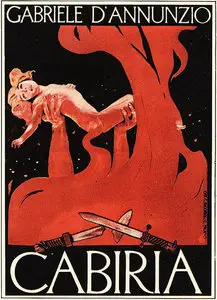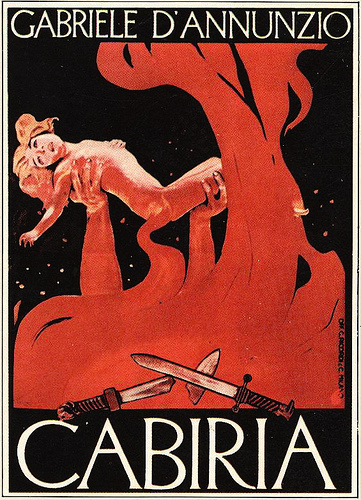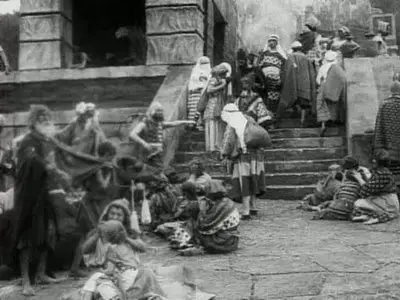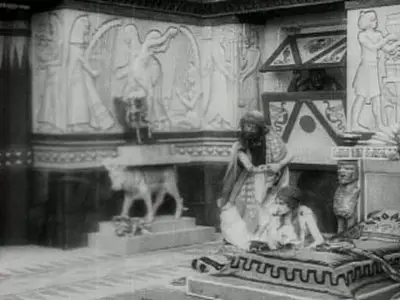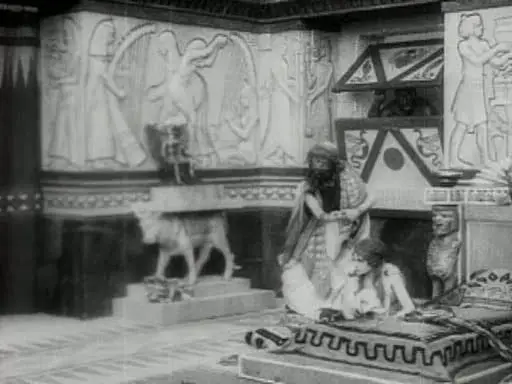Cabiria (Giovanni Pastrone, 1914)
Silent | sub: Enlish | 126 min | 512×348 | XviD - 1542 kb/s | mp3 - 192 kbps | 1.37 GB
Genre: adventure, drama
Silent | sub: Enlish | 126 min | 512×348 | XviD - 1542 kb/s | mp3 - 192 kbps | 1.37 GB
Genre: adventure, drama
IMDB rating: 6.5/10 1,004 votes
IMDb link: http://www.imdb.com/title/tt0003740/
Directed by: Giovanni Pastrone
Starring: Carolina Catena, Lidia Quaranta, Gina Marangoni
IMDb link: http://www.imdb.com/title/tt0003740/
Directed by: Giovanni Pastrone
Starring: Carolina Catena, Lidia Quaranta, Gina Marangoni
arly influences on great filmmakers are sometimes forgotten in the wake of later films that historians decide are pivotal. Hence the questionable latter day importance of ‘pioneering’ films such as The Jazz Singer (1927). D.W. Griffith’s mammoth Intolerance (1916), an acknowledged pivotal American feature film, was conceived after a viewing of Cabiria and owes its broad scope and tracking camera movements to its Italian predecessor.
Under the pseudonym Piero Fosco, Cabiria’s director Giovanni Pastrone utilized innovative tracking dolly shots (before they were known as such) that not only freed the camera from the static proscenium effect imposed on the motion picture camera by theatrical and still photography traditions, Pastrone’s moving camera did much to replicate the point of view of an observer moving about within the scene. A first-time viewer of Cabiria can unconsciously expect the stone-still dramatic cinematography of standard silent era films. The first camera movement in Cabiria, only minutes into the film, can have an electric effect on even today’s viewers, and certainly must have been shocking, even unsettling, to audiences of 1914. And note that Pastrone’s camera movements are not the in-and-out movements of Griffith’s Intolerance, they are lateral movements that eschew right angles producing a profound cinematic experience. The influence of such groundbreaking cinematography was immediate and can be seen in American films that predate Intolerance, such as His New Job (1915).
Cabiria also continued the recent Italian tradition of historical epic feature films such as Quo Vadis? (1912) and The Last Days of Pompeii (1913) that were pushing American filmmakers toward a full-time commitment to feature film production. Cabiria features stunning location photography, lavish costumes, ambitious special effects, and jaw-dropping gigantic sets full of intricate design detailing. Conceived as a serious artistic and literary project (the film is divided up into ‘chapters’), Cabiria succeeds on nearly all fronts. For us, the number and length of the verbose intertitles (originally written by Italian novelist Gabriele D’Annunzio) interrupts the flow of the film. D’Annunzio was brought into the project after filming was complete to overlay a literary aura on Cabiria through the use of his name, and he must have felt compelled to make his presence known.
The story of a young Roman girl separated from her parents and thrust into the ancient world has the requisite scope and breadth for an epic tale. For there is no shortage of circuitous events, tragic outcomes, clandestine rescues, and grandiose action that would disappoint fanatics of epic films. We are continually entertained by the sacrificial Moloch cult sequences, with its signature set that influenced films such as Metropolis (1927). The amateur actor Bartolomeo Pagano, discovered as a Genoa dockworker, is famous today as a standout in a competant cast as the Herculian Maciste, protector of Cabiria. Pagano was so successful in his charactization that he continued to portray Maciste in a series of popular Italian films into the twenties. — Carl Bennett
http://rapidshare.com/files/377666250/Cabiria.part1.rar
http://rapidshare.com/files/377692207/Cabiria.part2.rar
http://rapidshare.com/files/377718425/Cabiria.part3.rar
http://rapidshare.com/files/377745814/Cabiria.part4.rar
http://rapidshare.com/files/377778903/Cabiria.part5.rar
http://rapidshare.com/files/377804066/Cabiria.part6.rar
http://rapidshare.com/files/377821839/Cabiria.part7.rar
http://rapidshare.com/files/377639507/Cabiria.part8.rar
http://rapidshare.com/files/377692207/Cabiria.part2.rar
http://rapidshare.com/files/377718425/Cabiria.part3.rar
http://rapidshare.com/files/377745814/Cabiria.part4.rar
http://rapidshare.com/files/377778903/Cabiria.part5.rar
http://rapidshare.com/files/377804066/Cabiria.part6.rar
http://rapidshare.com/files/377821839/Cabiria.part7.rar
http://rapidshare.com/files/377639507/Cabiria.part8.rar
Subtitle: english intertitles


